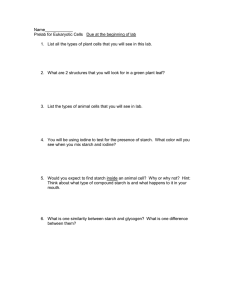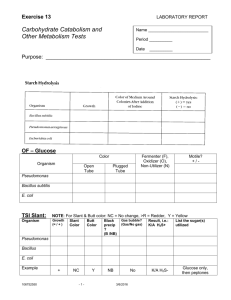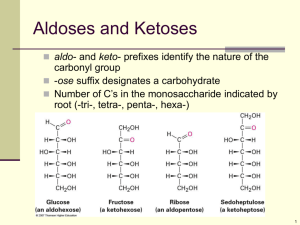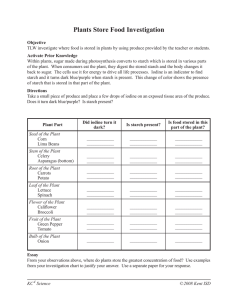lab lecture notes for week 7
advertisement
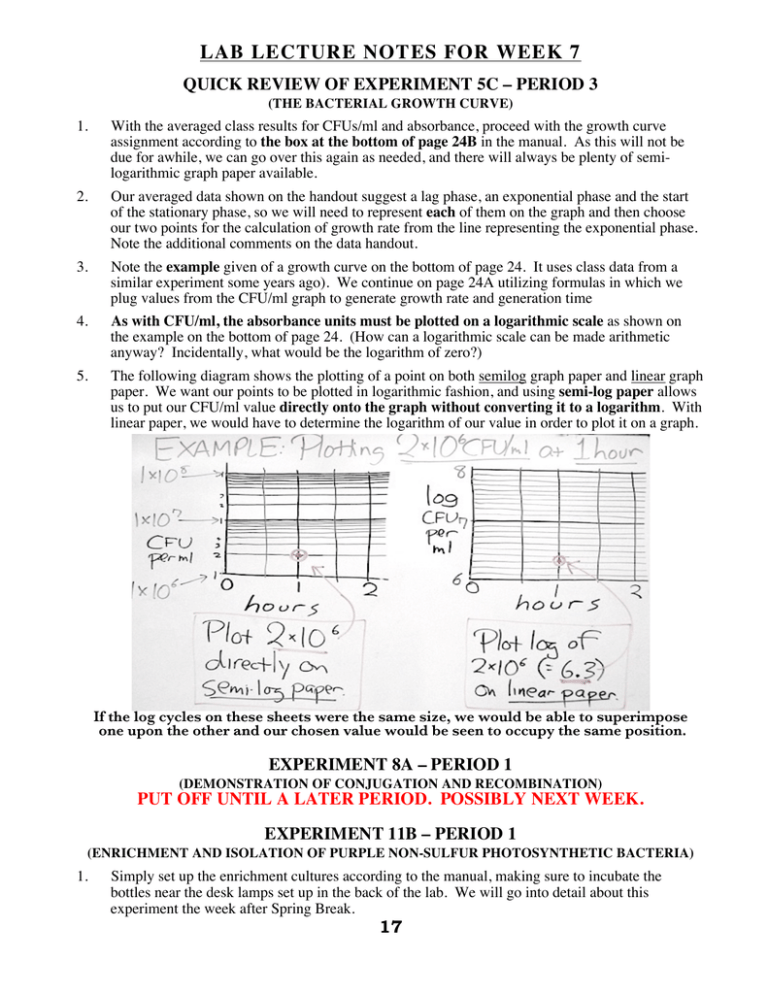
LAB LECTURE NOTES FOR WEEK 7 QUICK REVIEW OF EXPERIMENT 5C – PERIOD 3 (THE BACTERIAL GROWTH CURVE) 1. With the averaged class results for CFUs/ml and absorbance, proceed with the growth curve assignment according to the box at the bottom of page 24B in the manual. As this will not be due for awhile, we can go over this again as needed, and there will always be plenty of semilogarithmic graph paper available. 2. Our averaged data shown on the handout suggest a lag phase, an exponential phase and the start of the stationary phase, so we will need to represent each of them on the graph and then choose our two points for the calculation of growth rate from the line representing the exponential phase. Note the additional comments on the data handout. 3. Note the example given of a growth curve on the bottom of page 24. It uses class data from a similar experiment some years ago). We continue on page 24A utilizing formulas in which we plug values from the CFU/ml graph to generate growth rate and generation time 4. As with CFU/ml, the absorbance units must be plotted on a logarithmic scale as shown on the example on the bottom of page 24. (How can a logarithmic scale can be made arithmetic anyway? Incidentally, what would be the logarithm of zero?) 5. The following diagram shows the plotting of a point on both semilog graph paper and linear graph paper. We want our points to be plotted in logarithmic fashion, and using semi-log paper allows us to put our CFU/ml value directly onto the graph without converting it to a logarithm. With linear paper, we would have to determine the logarithm of our value in order to plot it on a graph. If the log cycles on these sheets were the same size, we would be able to superimpose one upon the other and our chosen value would be seen to occupy the same position. EXPERIMENT 8A – PERIOD 1 (DEMONSTRATION OF CONJUGATION AND RECOMBINATION) PUT OFF UNTIL A LATER PERIOD. POSSIBLY NEXT WEEK. EXPERIMENT 11B – PERIOD 1 (ENRICHMENT AND ISOLATION OF PURPLE NON-SULFUR PHOTOSYNTHETIC BACTERIA) 1. Simply set up the enrichment cultures according to the manual, making sure to incubate the bottles near the desk lamps set up in the back of the lab. We will go into detail about this experiment the week after Spring Break. 17 EXPERIMENT 7 – PERIOD 2 (PHENOTYPIC CHARACTERIZATION & IDENTIFICATION OF BACTERIA) 1. Brief review of the tests which are actually described well in Appendix G as to what to look for regarding positive and negative reactions. We made special note about the following: a. We use Glucose Fermentation Broth in Experiment 7A for the detection of acid (and possibly gas) produced by fermenting organisms. See Lab Lecture Notes for Period 5 (p. 16). Next week we will demonstrate Glucose O/F Medium. Taking Glucose Fermentation Broth, if we were to decrease the amino acid content and increase the glucose content, we would have less interference from alkaline ammonia formation and a greater ability to detect acid formation from glucose breakdown – even the small amount of acid associated with aerobic respiration. Some questions (with answers) that can be asked with Glucose Fermentation Broth in mind: (1) What process can interfere with the detection of an acidic reaction? Answer: An alkaline reaction from the breakdown of amino acids, namely deamination. (2) What process allows for anaerobic growth? Answer: Fermentation. (3) What test do we run in Exp. 7 which correlates with respiration? Answer: The catalase test. 2. b. Nitrate Broth is used to detect reduction of nitrate to nitrite which occurs when certain respiring organisms use nitrate as electron acceptor (in place of oxygen) and reduce it to nitrite. This is anaerobic respiration – not to be confused with fermentation. One of our twelve known organisms reduces it further to nitrogen gas which collects in the Durham tube. c. Motility Medium must be observed as described in step 3 (a and b) in order to see whether or not migration of the organisms from the line of inoculation has occurred. Motile organisms will populate the entire tube and make the medium thoroughly cloudy. d. Starch Agar is basically an all-purpose medium to which starch is added. (1) An organism which grows on the medium may be able to break down the starch. In that case, the starch disappears around the growth of the organism, and there is no color reaction when iodine is added. (2) Amylase is the enzyme that breaks down starch, and it does so outside of the organism. It is an extracellular enzyme, meaning it is produced by the organism and then transported outside of the cell where it can break down starch into smaller subunits (like glucose and maltose) which are then small enough to enter the cell. (3) Iodine and starch combine to form a purple-colored compound, and a plate containing an organism which cannot break down starch will be completely purple when iodine is added, as the starch is still present in the medium.) As time permits – in addition to recording the results for your unknown and known cultures – go around your neighborhood and check the results of more of the known cultures and record the results on page 34. If all twelve known cultures cannot be recorded, at least see what a positive result and a negative result look like in each medium. 18
